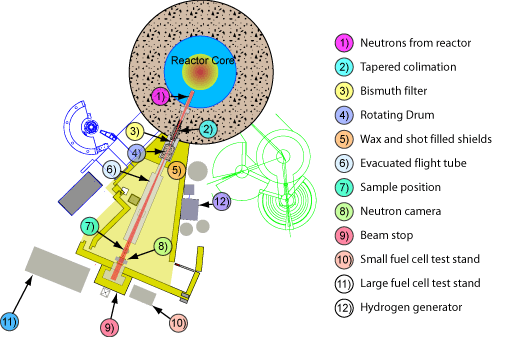Neutron Imaging Facility
Figure 1. Neutron imaging facility
Facility Features
This facility (see Fig. 1 above) is located at Beam Tube 2 (BT-2) at
the NIST CNR. Here the CNR provides an
extremely intense source of thermal neutrons that is collimated using a tapered
plug (1 and 2 in Fig. 2). This conically shaped beam will be nearly
uniform in intensity across the diameter of the beam at the image plane
downstream. This type of optical arangement is generally refered to as pinhole
optics.
 Figure 2.
Figure 2. Plan view of the neutron imaging facility pointing out some
major features.
Although the CNR produces mostly thermal neutrons there are still a significant
amount of high energy neutrons and gamma rays as a byproduct. These high energy
neutrons and gamma rays represent a background that can be dangerous to
electronic equipment and to personnel operating the beam line. Therefore, a
high energy neutron and gamma ray filter is placed directly downstream of the
tapered collimator. This filter consists of 10 cm of bismuth single crystal
cooled to liquid nitrogen (LN) temperatures (77 K) (3 in Fig. 2).
Cooling the bismuth dramatically reduces the vibrational phonon modes in the
crystal, which strongly scatter thermal neutrons. Cooled the crystal becomes
nearly transparent (60 % transmission) to thermal neutrons and remains
nearly opaque to high energy neutrons and gamma rays.
The filtered beam can then be collimated with a simple thermal neutron pinhole
located directly downstream of the LN cooled bismuth filter. The maximum
diameter of this pinhole is 2 cm and the minimum size is unrestricted,
however the current system is setup to use a 2 cm, 1.5 cm,
1.0 cm, 0.5 cm, or 0.1 cm aperture. Using a 2 cm aperture
produces an effective L/d ratio (to be discussed later) of 300. Smaller
diameter apertures increase this ratio and enhance the resolution of images.
The full range of parameters are shown in Table 1.
Table 1. General beam characteristics are described here. The last
column shows the values for no filter for the sake of comparison to other
neutron radiography facilities.
L
(m) |
Aperture
d
(cm) |
L/d
|
Beam
diameter
(cm) |
15 cm bismuth filter
Fluence Rate
(cm-2 s-1) |
No filter
Fluence Rate
(cm-2 s-1) |
| 2 |
2 |
100 |
8 |
5.1 � 107 |
3.0 � 108 |
| 3 |
2 |
150 |
13 |
3.4 � 107 |
2.0 � 108 |
| 4 |
2 |
200 |
17 |
2.5 � 107 |
1.5 � 108 |
| 6 |
2 |
300 |
26 |
1.7 � 107 |
1.0 � 108 |
| 6 |
1.5 |
400 |
26 |
1.0 � 107 |
5.9 � 107 |
| 6 |
1.0 |
600 |
26 |
4.3 � 106 |
2.5 � 107 |
| 6 |
0.5 |
1200 |
26 |
1.0 � 106 |
5.9 � 106 |
| 6 |
0.1 |
6000 |
26 |
4.3 � 104 |
2.5 � 105 |
After the pinhole is a rotating drum with four positions (4 in Fig. 2).
Three of the positions have holes for additional collimation or filters if
needed. These collimators are currently 1 cm, 2 cm, and open
collimation. The fourth position is used to block the beam when the facility is
not in use.
Neutrons and gamma rays scattered out of the beam must be stopped to prevent
them from becoming a hazard to personnel or to other scientific neutron data
collection experiments in the CNR. The shielding used to do this is a steel
encased mixture of wax and steel shot. The high energy neutrons are turned into
thermal neutrons in the wax and stopped be the material and the gammas are
absorbed by the steel shot (see 5 in Fig. 2).
The beam that is now collimated passes out of the drum and into a sealed,
evacuated aluminum flight tube (6 in Fig. 2). The flight tube ends right
before the sample position (7 in Fig. 2), which is open to air. At the
sample position an object to be radiographed sits on a rotating and translating
stage. Behind the object is the neutron camera that
is used to digitize the 2-dimensional neutron distribution (8 in Fig. 2).
Finally the beam is stopped in an appropriately named "beam stop"
(9 in Fig. 2). The beam stop is necessary since the sample and camera do
not stop all of the neutrons plus high energy neutrons and gammas are still
present in the beam. Therefore, for the interest of safety the beam stop is
designed to stop the unattenuated beam (beam without obstructions like the
sample and camera).
Inquiries or comments:
David
Jacobson
Online: July 2004 - Last update: May 2006
|


